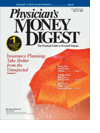Publication
Article
Physician's Money Digest
Build a Financial Future with Housing
Author(s):
For many Americans, the real estate boom ofthe past several years has left them sitting ona gold mine. According to data from CaseShiller Weiss, the nation's premier housingresearcher, the price of the average US home hasincreased nearly 42% over the past 5 years. But that'sjust the average price increase.
In the Providence, RI, market, home prices haverisen 93.7% during the same time period and 87.1%in Oakland, Calif. Even in Burlington, Vt, homeprices have jumped 50.6% over the past 5 years,exceeding the national average.
The surge in home prices coincides with droppingmortgage rates. The current average 30-year fixedmortgage rate is 5.67%. The result is that homeownersare tapping into their equity, refinancing, taking outhome equity loans, and feverishly remodeling.Consider that in 2003, total cash raised through refinancing, home equity loans, and lines of credit reached$223 billion, according to Economy.com. In addition,homeowners spent $124 billion on remodeling.
Home Equity Boom
Money
What's happening, a recent article notes, isthat homeowners are transferring their hopes andretirement investments from stocks to housing. Therationale is that with home values rising, homeownerscan tap into their expanding equity to help eliminatecredit card debt and fund retirement. And becausemortgage interest is tax-deductible, if homeowners dosell at some point, much of their profit will be tax-free.
The above numbers, however, tell only half thestory. Real estate in more than half of the countryappreciated between 2% and 5% in 2003. That's a farcry from the national average of 8%. And just as thetech-stock bubble burst 4 years ago, the hottest marketstoday face the greatest risks.
Money
For example, the article points out howmany homeowners are acting as rich as they feel.They're tapping into their equity as though they wereturning on the water from a faucet, funding everythingfrom summer camps and vacations to jacuzzis inthe bathrooms. The problem is that the home equitywell could run dry.
Consider that interest rates are now beginning torise, and will continue moving up. As this happens,the value of your home can drop, or at least stagnate,and the carrying costs on your credit line or adjustablerate mortgage can spike. Cash flow could become aproblem, and in a worst-case scenario, you could endup owing more than you own.
Debt Dilemma
Money
The article highlights the risks of taking ontoo much debt from several perspectives. First, if youborrow 100% of the value of your home and yourhome values drop 10%, you will owe money if youdecide or need to sell. You'll also have lost your safetynet. And if you have to sell to relocate for a job, orneed cash to address an unexpected medical situation,your cushion won't be there for you.
In the case of rising interest rates, Economy.comnotes that since 1998, mortgage debt as a percentage ofpersonal income has increased from 55% to 73%. A$250,000 mortgage at 5.67% interest requires a monthlypayment of $1446. However, if the interest rate rises2%, which would place it at the historical average,mortgage payments would increase by $331 a month.You could find that you've stretched yourself too thin.
Remember:
Along those lines, keep in mind that the averagesize of new homes increased from 1905 square feet in1987 to 2320 square feet in 2002. Buoyed by lowinterest rates, homeowners are buying larger, moreexpensive homes with more amenities. Bigger might not necessarily be better. And if you'rebuying with an adjustable rate mortgage, be certainyou can afford the high payments should interest ratescontinue to rise.
